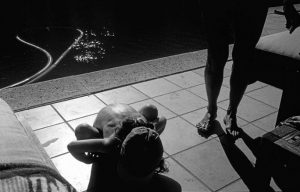May 15, 2002
Janice Mauro’s sculptures have always embraced the female form as the nexus of potency. Her hydro-cal sculptures, fashioned to look like marble, have a classical dignity to them, with a feminist twist. Her images of naked women standing unabashedly forward, their hands cupped below their wombs, their expressions graced with a pacific dignity, have an iconic status for Mauro.

But in a new exhibit with photographer Elizabeth Richebourg Rea at New Arts Studio in Litchfield, the Waterbury sculptor extends the fertility to a familial community. In this respect, her sculptures amplify the more prosaic narratives captured by Rea. The two artists work together to accentuate a powerful theme: the role of women as the locus of energy in a family setting.
The theme is subtly drawn, but inescapable. Mauro’s female nudes, though increasingly paired with their male counterparts, are clearly the generators of great physical and emotional power. In a series of three images, a man and woman are drawn together, admire the woman’s enlarged belly and finally embrace a cherub who suckles at the woman’s breast.
Although the man is positioned lovingly beside the woman, it is clearly she who provides the wonder and the sustenance for life. Similarly, in images like “Solstice,” a man reclines dolefully on the lap of a woman, her body umbrellad over him in succor. In ‘What Love Is,” a man and woman are joined at the ear, a clear homage to understanding between a couple.
And in the large focal point on the second floor of this splendidly capacious gallery, “Eve’s Knowledge,” a life-size image in Microcrystalline wax and mixed media, a woman sits cross legged on a chair, peeling an apple with a knife. This fluent, reposed, contemplative figure exudes a serenity and wisdom even more pronounced than in most of Mauro’s figures.
Against all of this, an engaging familial narrative alights along the gallery walls. Rea’s photographs of intimate family moments, some in black and white and others in an almost luridly red neon, illuminate the ordinary moments of a family on vacation. It appears like a three-generation family trying to balance a mother’s exhausted quest for laziness, with the vigorous curiosity of youth and the lonely torpor of old age.
Through all of these moments, Rea tries to turn the prosaic into the poignant, with varying degrees of success. In the best images, like “Creepy Crawler,” a lovely composition in black and white, a little girl by the side of a pool leans so close to the tile that her nose almost touches it. Beside her, the bones of her mother’s feet make a marvelous echo to the curve of the little girl’s spine.
Mothers and daughters are a particular area of success. The girls are at their most awkward, innocent and all-knowing best. Their insolent puckers mirror those of their mothers; their ballerina costumes are designed to impress. This is femininity at its most embryonic. And Rea captures it with an electric enthusiasm, blessedly devoid of irony.
As Rea has said, “Photography is unique in its ability to separate out from the complex flow of our lives, a single telling moment – the reluctant pause, the missed signal, the sense of sudden bewilderment, the sensation of loss. My photography becomes my marker of time and exposes the deepest memories of my life.” They are memories that should resonate with anyone who has had a family.
The New Arts Gallery is at 513 Maple St., Litchfield, just off of Milton Street below the center of town. The exhibit ends May 27. For information, call (860) 567-5015.